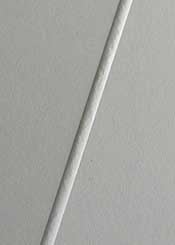Can I use my Tri-Creaser to score signatures or brochures where there are 2 or 3 thicknesses of paper being scored at one time?
 Yes, you can. In fact the mix of male creasing ribs and multiple female channels available on the Tri-Creaser provides many options for fine tuning the width and depth of the score on this type of work. We even have some clients who purchased the device for that sole purpose.
Yes, you can. In fact the mix of male creasing ribs and multiple female channels available on the Tri-Creaser provides many options for fine tuning the width and depth of the score on this type of work. We even have some clients who purchased the device for that sole purpose.
A little background however, is important in understanding the differences between creasing single sheet work and scoring multiple sheets simultaneously. Our rotary creasing tools were originally designed to mimic the creasing of a die-cutter or letter press so as to eliminate fiber cracking. To achieve this result, it’s necessary to process one sheet at a time, whether in platen (die cutter) or rotary format. The male creasing rule or rib pushes the sheet into a female channel with the resulting “bead” on the inside of the folded piece.
Signatures (e.g. 8 or 12pp) or broadside type brochures (e.g. fold in half in the parallel section and one or more folds in the right angle) are different. Here you’ll have 2 or more sheets that need to be scored as they exit the parallel section, before folding in the right angle section.
A side note: The terms ‘creasing’ and ‘scoring’ are often used interchangeably, depending on which segment of the printing and bindery industry you’re talking to. For the purpose of this discussion we’ll use the following definitions. Creasing refers to the compression and internal delamination of the sheet so as to prevent fiber cracking once the piece is folded. Scoring refers to the weakening of a sheet (or sheets) along a line so it will fold where it’s supposed to fold. Elimination of fiber cracking may or may not occur when scoring.
 When scoring multiple sheets, the male portion of the scoring component is usually on the inside of the fold, which is the opposite of the creasing setup. The Tri-Creaser gives you numerous options for controlling the width and depth of the score not always available with OEM or traditional scoring devices. You can create a sharp, well-defined score (right) to perfectly suit your stock and this can be a huge aid in folding machine productivity as well as in the overall look of the final folded piece.
When scoring multiple sheets, the male portion of the scoring component is usually on the inside of the fold, which is the opposite of the creasing setup. The Tri-Creaser gives you numerous options for controlling the width and depth of the score not always available with OEM or traditional scoring devices. You can create a sharp, well-defined score (right) to perfectly suit your stock and this can be a huge aid in folding machine productivity as well as in the overall look of the final folded piece.
Remember though, if eliminating fiber cracking is your primary goal you will probably have to crease the job as a single sheet, before any folds are done. Having said that however, we can say we’ve successfully creased 2 or 3 sheets in 8 and 12pp signatures so that fiber cracking disappeared. Sometimes the male component was on the outside of the fold; other times on the inside. It’s the exception to the rule, and it just shows that almost everything is worth testing once.
So don’t hesitate to get maximum results from your Tri-Creaser by exploring alternate uses. A little trial and error may be needed at first. Once you’ve got a good setting for a particular job, whether it’s single-sheet creasing or multiple-sheet scoring, make a note for the next time around and your setup time will be minimal.

